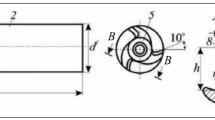A systematic approach is considered for effective use of high density ceramic for manufacturing cutting and working tools, based on use of a model constructed for their operation and separate levels of controlling their operating properties. A mechanism is developed for controlling the operating properties of ceramic tools, aimed at creating conditions forming the minimum level of micro- and macrostresses, reducing the probability of development of operating defects, increasing the time for defect-free operation of tools, reducing wear intensity and the probability of unpredictable failure.
Similar content being viewed by others
References
V. V. Kuzin, Tools with Ceramic Cutting Tips [in Russian], Yanus-K, Moscow (2006).
S. N. Grigor’ev, M. A. Volosova, and V. G. Borovskii, “Technological provision of surface layer quality for a ceramic tool in order to increase its operating efficiency during machining of hardened steels,” Stanki i Instrument, No. 9, 14 – 19 (2005).
A. G. Evans and T. G. Langdon, Structural Ceramics [Russian translation], Metallurgiya, Moscow (1980).
G. G. Gnesin, “Main directions of research and development of non-oxide ceramic materials,” Ogneupory Tekhn. Keram., No. 5, 2 – 7 (2000).
Contact Reaction Mechanics [in Russian], Fizmatgiz, Moscow (2001).
B. R. Lawn and G. R.Wilshaw, “Indentation fracture: principles and application,” J. Mat. Sci., 10, No. 6, 1049 – 1081 (1975).
O. G. Chekina, “Modelling failure of surface layers with contact of rough bodies,” Proc. 9th Conf. on Strength and Ductility, Vol. 1, Moscow (1996).
A. C. Cocks and M. F. Ashby, “The growth of a dominant crack in a creeping material,” Scr. Metall., 16, 101 – 114 (1982).
B. A. Drozdovskii and Ya. B. Fridman (editors), Applied Questions of Fracture Toughness [Russian translation], Mir, Moscow (1968).
G. A. Gogotsi and Ya. L. Grushevskii, “ Classification of refractories with respect to the nature of brittleness and evaluation of their thermal shock resistance,” Ogneupory, No. 4, 48052 (1978).
H. Hubner and W. Jilek, “Sub-critical crack extension and crack resistance in polycrystalline alumina,” J. Mat. Sci., 12, No. 117 – 125 (1977).
Yu. L. Krasulin, S. M. Barinov, and V. S. Ivanov, Structure and Failure of Materials of Refractory Compound Powders [in Russian], Nauka, Moscow 91985).
S. N. Grigor’ev and M. A. Volosova, “technology of combined surface strengthening of a cutting tool of oxide-carbon ceramic”, Vestn. Mashinostroenie, No. 9, 32 – 36 (2006).
M. A. Volosova and S. N. Grigor’ev, “Production principles of depositing wear-resistant nano-coatings using tool manufacture,” Uprochnyayushchie Tekhnologiya i Pokrytiya, No. 6, 37 – 42 (2010).
Author information
Authors and Affiliations
Additional information
Translated from Novye Ogneupory, No. 12, pp. 13 – 19, December 2010.
Rights and permissions
About this article
Cite this article
Kuzin, V.V. Effective use of high density ceramic for manufacture of cutting and working tools. Refract Ind Ceram 51, 421–426 (2011). https://doi.org/10.1007/s11148-011-9342-9
Received:
Published:
Issue Date:
DOI: https://doi.org/10.1007/s11148-011-9342-9




